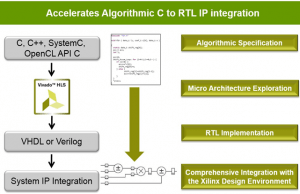High-Level Synthesis with the Vitis Unified IDE
✅ Indicates CONFIRMED TO RUN
Course Description
This course provides a thorough introduction to the Vitis™ High-Level Synthesis (HLS) tool. The focus is on:
- Converting C/C++ designs into RTL implementations
- Learning the Vitis HLS tool flow
- Creating I/O interfaces for designs by using the Vitis HLS tool
- Applying different optimization techniques
- Improving throughput, area, latency, and logic by using different HLS pragmas/directives
- Exporting IP that can be used with the Vivado® IP catalog
- Migrating designs from the classic Vitis HLS tool to the Vitis Unified IDE
Level
DSP 3
Course Duration
2 days
Audience
Software and hardware engineers looking to utilize high-level synthesis
Prerequisites
- C, C++, or System C knowledge
- High-level synthesis for software engineers OR high-level synthesis for hardware engineers
Software Tools
- Vitis HLS tool 2023.2
- Vivado Design Suite 2023.2
- Vitis Unified IDE 2023.2
Hardware
- Architecture: Zynq® UltraScale+™ MPSoC and Versal® AI Core series*
- Demo board: ZynqUltraScale+ MPSoC ZCU104 board*
* This course focuses on the Zynq UltraScale+ MPSoC architecture. Check with your local Authorized Training Provider for the specifics of the in-class lab board or other customizations
Skills Gained
After completing this comprehensive training, you will know how to:
- Enhance productivity by using the Vivado HLS tool
- Describe the high-level synthesis flow
- Use the Vitis Unified IDE to create an HLS component
- Identify the importance of the testbench
- Use directives to improve performance and area and select RTL interfaces
- Perform system-level integration of IP generated by the Vitis Unified IDE
- Migrate designs from the classic Vitis HLS tool to the Vitis Unified IDE
Course Outline
Day 1
- Introduction to High-Level Synthesis – Provides an overview of high-level synthesis (HLS), the Vitis Unified IDE for HLS flow, and the verification advantage. {Lecture}
- HLS Component Development Flow – Explores the HLS component development flow in the Vitis Unified IDE. {Lecture, Lab}
- Abstract Parallel Programming Model for HLS – Describes the structuring of a design at a high level using anabstract parallel programming model. {Lecture}
- Design Exploration with Directives – Explore different optimization techniques that can improve the design performance. {Lecture}
- HLS Component Development Using the Command Line – Describes the unified command line interface and the the v++ and vitis-run commands. {Lecture, Lab}
- Introduction to Vitis HLS Design Methodology – Introduces the methodology guidelines covered in this course and the HLS Design Methodology steps. {Lecture}
- Introduction to I/O Interfaces – Explains interfaces such as block-level and port-level protocols abstracted by the Vitis HLS tool from the C design. {Lecture}
- Block-Level Protocols – Explains the different types of block-level protocols abstracted by the Vitis HLS tool. {Lecture, Lab}
- Port-Level I/O Protocols – Describes the port-level interface protocols abstracted by the Vitis HLS tool from the C design. {Lecture, Demo, Lab}
- AXI4 Adapter Interface Protocols – Explains the different AXI interfaces (such as AXI4-Master, AXI4-Lite (Slave), and AXI4-Stream) supported by the Vitis HLS tool. {Lecture, Demo}
- Optimizing for Performance: PIPELINE – Describes the PIPELINE directive for improving the throughput of a design. {Lecture, Lab}
Day 2
- Optimizing for Performance: DATAFLOW – Describes the DATAFLOW directive for improving the throughput of a design by pipelining the functions to execute as soon as possible. {Lecture, Lab}
- Optimizing for Throughput – Identify the performance limitations caused by arrays in your design. You will also explore optimization techniques to handle arrays for improving performance. {Lecture, Demo, Lab}
- Optimizing for Latency: Default Behavior – Describes the default behavior of the Vitis HLS tool on latency and throughput. {Lecture}
- Optimizing for Latency: Reducing Latency – Describes how to optimize the C design to improve latency. {Lecture}
- Optimizing AXI System Performance – Describes AXI burst transfers and their types. Also outlines the optimization steps to improve system performance. {Lecture}
- Vitis HLS Libraries – Describes the library support offered by Vitis HLS. {Lecture}
- Vitis HLS Libraries: Arbitrary Precision Data Types – Describes Vitis HLS support for the C/C++ languages as well as arbitrary precision data types. {Lecture, Lab}
- Using Pointers in Vitis HLS – Explains the use of pointers in a design and workarounds for some of the limitations. {Lecture}
- HLS Component Design Flow – System Integration – Illustrates the process of developing and exporting an HLS component as Vivado IP. {Lab}
- Migrating to the Vitis Unified IDE – HLS Component – Describes the need for the Vitis Unified IDE and identifies different approaches for migrating projects from the classic Vitis HLS tool to the Vitis Unified IDE. {Lecture, Lab}

Datum
08 april 2024 - 09 april 2024
Locatie
Core|Vision
Cereslaan 24
5384 VT
Heesch
Prijs
€ 0,00
of
20 Xilinx Training Credits
Informatie
Training brochure
Registratieformulier
Registratie op aanvraag, neem contact op met ons.
